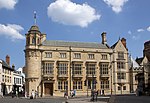Hertford College, Oxford

Hertford College ( HART-fərd), previously known as Magdalen Hall, is a constituent college of the University of Oxford in England. It is located on Catte Street in the centre of Oxford, directly opposite the main gate to the Bodleian Library. The college is known for its iconic bridge, the Bridge of Sighs. There are around 600 students at the college at any one time, comprising undergraduates, graduates and visiting students from overseas. The first foundation on the Hertford site began in the 1280s as Hart Hall and became a college in 1740 but was dissolved in 1816. In 1820, the site was taken over by Magdalen Hall, which had emerged around 1490 on a site adjacent to Magdalen College. In 1874, Magdalen Hall was incorporated as a college, reviving the name Hertford College. In 1974, Hertford was part of the first group of all-male Oxford colleges to admit women.Alumni of the college's predecessor institutions include William Tyndale, John Donne, Thomas Hobbes, and Jonathan Swift. More recently, former students have included author Evelyn Waugh, the first female Home Secretary Jacqui Smith, the civil servants Jeremy Heywood and Olly Robbins, and the newsreaders and reporters Fiona Bruce, Carrie Gracie, Krishnan Guru-Murthy, and Natasha Kaplinsky. U.S. justice Byron White attended the college on a Rhodes scholarship but left to serve in World War II.
Excerpt from the Wikipedia article Hertford College, Oxford (License: CC BY-SA 3.0, Authors, Images).Hertford College, Oxford
Holywell Street, Oxford City Centre
Geographical coordinates (GPS) Address External links Nearby Places Show on map
Geographical coordinates (GPS)
| Latitude | Longitude |
|---|---|
| N 51.754205 ° | E -1.253467 ° |
Address
Hertford College
Holywell Street
OX1 3SD Oxford, City Centre
England, United Kingdom
Open on Google Maps








